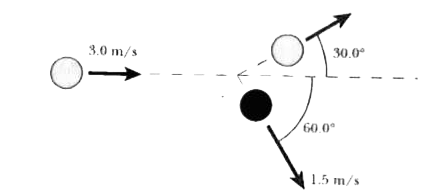A football player kicks a 0.41 kg football initially at rest, and the ball flies through the air. If the kicker's foot was in contact with the ball for 0.051 s and the ball's initial speed after the collision is 21 m/s, what was the magnitude of the average force on the football?
9.7 N
46 N
81 N
210 N
The correct Answer is:D
To find the magnitude of the average force exerted on the football, we can use the relationship between force, change in momentum, and time. Here’s a step-by-step solution:
Step 1: Understand the problem
The football player kicks a football of mass m=0.41kg which was initially at rest. The ball reaches a speed of vf=21m/s after being kicked, and the contact time t=0.051s.
Step 2: Calculate the change in momentum
The change in momentum (Δp) can be calculated using the formula:
Δp=m⋅(vf−vi)
where vi is the initial velocity. Since the ball is initially at rest, vi=0m/s.
Substituting the values:
Δp=0.41kg⋅(21m/s−0m/s)=0.41kg⋅21m/s
Δp=8.61kg m/s
Step 3: Calculate the average force
The average force (Favg) can be calculated using the formula:
Favg=Δpt
Substituting the values we have:
Favg=8.61kg m/s0.051s
Favg≈168.8N
Final Answer
The magnitude of the average force on the football is approximately 168.8N.
---
The football player kicks a football of mass m=0.41kg which was initially at rest. The ball reaches a speed of vf=21m/s after being kicked, and the contact time t=0.051s.
The change in momentum (Δp) can be calculated using the formula:
Δp=m⋅(vf−vi)
where vi is the initial velocity. Since the ball is initially at rest, vi=0m/s.
Δp=0.41kg⋅(21m/s−0m/s)=0.41kg⋅21m/s
Δp=8.61kg m/s
The average force (Favg) can be calculated using the formula:
Favg=Δpt
Substituting the values we have:
Favg=8.61kg m/s0.051s
Favg≈168.8N
The magnitude of the average force on the football is approximately 168.8N.
Topper's Solved these Questions
- BOOK - RESNICK AND HALLIDAYCHAPTER - CENTER OF MASS EXERCISE - Practice Questions (More than One Correct Choice)5videos
CENTER OF MASS
- BOOK - RESNICK AND HALLIDAYCHAPTER - CENTER OF MASS EXERCISE - Practice Questions (Linked Comprehension)6videos
CENTER OF MASS
- BOOK - RESNICK AND HALLIDAYCHAPTER - CENTER OF MASS EXERCISE - Problems46videos
CENTER OF MASS
- BOOK - RESNICK AND HALLIDAYCHAPTER - CAPACITANCEEXERCISE - PRACTICE QUESTION (INTEGER TYPE)3videos
CAPACITANCE
- BOOK - RESNICK AND HALLIDAYCHAPTER - CIRCUITSEXERCISE - Practice Questions (Integer Type)3videos
CIRCUITS
Similar Questions
A golf player hits a golf ball of mass 100 g and imparts it a speed of 50 m/s. If golf stick remains in contact with the ball for 0.01 s, then the average force exerted by the golf stick on the ball.
View SolutionIn the game of billiards, all the balls have approximately the same mass, about 0.17 kg. In the figure, the cue ball strikes another ball such that it follows the path shown. The other ball has a speed of 1.5 m/s immediately after the collision. What is the speed of the cue ball after the collision?
 View Solution
View Solution
Knowledge Check
- Question 1 - Select One
A 0.065 kg tennis ball moving to the right with a speed of 15 m/s is struck by a tennis racket, causing it to move to the left with a speed of 15 m/s. If the ball remains in contact with the racquet for 0.020 s, what is the magnitude of the average force experienced by the ball?
A0NB98 NC160 ND240 N - Question 2 - Select One
A player kicks a football of mass 0.5 kg and the football begins to move with a velocity of 10 m/s . If the contact between the leg and the football lasts for 150sec , then the force acted on the football should be
A250 NB125 NC0 ND3⋅75N - Question 3 - Select One
A football player kicks a 0.25 kg ball and imparts it a velocity of 10 m/s. The contact between foot and the ball is only 150th of a second. The kicking force is
A250 NB125 NC0 ND3.78 N
A football of mass 0.42kg is passed with a velocity of 25ms−1 due south. A defending player lunges at the ball and deflects it so that the new velocity is 20ms−1 36.9∘ west of south . If the player is in contact with the ball for 0.05s , what is the magnitude of the average force he exerts
 View Solution
View SolutionA ball moving with speed v hits another identical ball at rest. The two balls stick together after collision. If specific heat of the material of the balls is S , the temperature rise resulting from the collision is
View SolutionA ball moving with speed v hits another identical ball at rest. The two balls stick together after collision. If specific heat of the material of the balls is S , the temperature rise resulting from the collision is
View SolutionA ball hits a wall horizontally at 6.0 m s−1. It rebounds horzontally at 4.4 m s−1. The ball is in contact with the wall for 0.040 s. What is the acceleration of the ball ?
View SolutionA golf ball of mass m is hit by a golf club so that the ball leaves the tee with speed v. The club is in contact with the ball for time T. The magnitude of the average force on the club on the ball during the time T is :
View Solution

